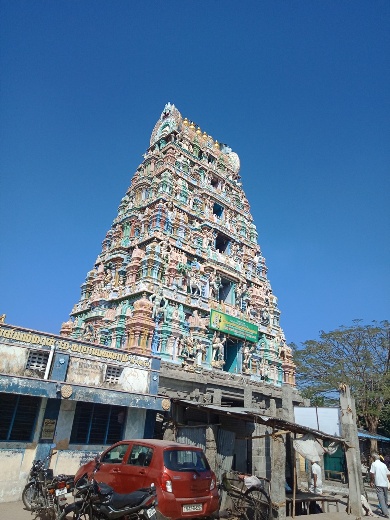Cheyyar Sri Vedapureeswarar Temple, Thiruvannamalai

Address
Cheyyar Sri Vedapureeswarar Temple Thiruvothur (Thiruvathipuram) Cheyyar-Taluk Thiruvannamalai District Tamil Nadu – 604 407. Tele: +91- 4182-224 387.
Diety
Vedapureswarar Amman: Valakujambigai
Introduction
Vedapureeswarar temple is a sacred place on the northern banks of the Cheyyar River in the Tiruvannamalai District near Kanchipuram in the state of Tamil Nadu in South India. This sacred place is now known as Cheyyar but was previously called Thiruvothur. This is one of the important towns in Thiruvanamalai district. It includes a sub-collector office, taluk office, two courts and a special prison.It is one of the shrines of the 275 Paadal Petra Sthalams. The temple is devoted to Lord Vedapuresswarar who came here and imparted his spiritual knowledge regarding the Vedas. According to legend, it is in this sacred place that Saint Thirugnanasambanthar used his holy miraculous powers and transformed a male palm tree into a female palm tree. Theertham (Holy water): Cheyyaru river and Kalyana Kodi Thertham Sthala Vriksham (Sacred Tree): Palm Tree
Puranic Significance
The legend is that Lord Shiva preached (meaning “Othu” in Tamil) Veda to celestial gods (Devas) and sages at this place, hence this place gets the name “Thiruvothoor” and the lord is praised as “Vedapureeswarar”. According to Hindu mythology, Dakshayani, daughter of Dakshan and the granddaughter of Lord Brahma was married to Lord Shiva. Once, when Dakshan was performing a grand yagna, he intentionally failed to invite Lord Shiva. Goddess Dakshayani took offence to this and decided to visit the Yagna against the wishes of her husband with the purpose of asking her father to invite Lord Shiva. But clouded by his arrogance and pride, Dakshan humiliated both Dakshayani and Lord Shiva. Furious, Dakshayani cursed her father that his Yagna would not be successful. Furthermore, she wanted to seek absolution for the sin of being the daughter of an opponent of Lord Shiva and decided to perform penance at this place (Thiruvothur). Another legend associated with this place is that a devotee of Lord Shiva who was looking after this temple, had grown palm trees on the banks of the river Cheyyar and around the temple’s fields to protect the temple’s walls from erosion and floods. However, all of these palm trees were male and did not yield any fruits. The Jains laughed at him and started taunting him by saying “why don’t you ask your God to change these male palm trees into female (fruit bearing) ones?”. When Saint Thirugnanasambanthar came to this temple, he was informed about this incident. It is believed that as a result of Thirugnanasambanthar’s hymns, all the male palm trees were transformed into female palm trees. Some of these trees can still be seen in this temple. Another legend is that when Saint Thirugnanasambanthar visited Thiruvothur, the Jains at this place conducted a yagna and sent a poisonous snake to kill him. He redirected the snake back to their leader who realized Sambanthar’s power and surrendered to him. Sambanthar prayed to Lord Shiva who then appeared as a snake charmer and took the snake away. To commemorate this incident, there is a huge idol of Nagalingam / Sri Naganathar (snake with five heads) installed in this temple. After failing in their attempts to kill him, the Jains invited Thirugnanasambanthar for a competition (Punalvadam in Tamil). During this competition, the Jains wrote their slokas on a palm leaf and put it in the river Cheyyar. This palm leaf got carried away in the river stream. Whereas when Thirugnanasambanthar did the same, the palm leaf in which he wrote his pathigam floated against the stream, came back and got stationed at a particular place. After this incident, it is believed that the Jains accepted their defeat. This place is called “Cheyyatril Ventran”. It is believed that similar type of incidents and competition had also taken place in Madurai. Even though Saint Thirunavukkarasar (Appar) is believed to have visited this temple and rendered pathigams, those pathigams have not been recovered. It is also said that Lord Shiva performed his “Veera Nadanam” here. This is one of the temples where Lord Murugan is believed to have worshiped Lord Shiva. The Cheyyaru river itself is believed to have been created by Lord Murugan and it serves as the Theertham of this temple. Another legend is that once, a local ruler by the name of Thondaiman requested Lord Shiva to help him conquer the kingdom of King Visuvasu. Lord Shiva sent Nandhi along with Thondaiman to help him defeat Visuvasu. In memory of this, Nandhi here is facing the entrance of the temple instead of facing the lord. Another legend about the Nandhi’s posture here is that when Lord Shiva preached Veda to the celestial gods and sages, Nandhi was instructed to keep a watch at the entrance to prevent any disturbances.
Beliefs
It is believed that those seeking “santhana prapthi” (child boon) can pray to the Goddess here by making offering of palm fruits and then consuming it. Devotees also worship Lord Shiva of this temple for prosperity and wisdom.
Special Features
On the left side of the entrance, there is a huge palm tree made of stone – half of it depicts a male palm tree and the other half depicts a female palm tree. Lord Shiva can be seen seated under this tree, and Saint Thirugnanasambanthar can also be seen at his side. Thirugnanasambanthar’s idol looks as if he is reciting his pathigam. Another significance of this temple is that from the centre of the main hall you can see and worship all the five deities at the same time – Lord Shiva, Goddess Parvathi, Vinayakar, Murugan, Navagraham and the Palm trees. This is a unique feature of this temple and you cannot find such placement of shrines in any other temple in Tamil Nadu.Another significance of this temple is that everyday sun rays fall directly on the Shivalingam. Saint Arunagirinadhar has also sang songs in praise of Lord Murugan of this temple in his revered Thirupugazh. Another significance of this temple is that in the outer corridor, separate shrines for all the five “Panchapootha” lingams can be seen. It is believed that devotees will get the benefit of visiting Kanchipuram, Thiruvanaikkaval, Sri Kalahasthi, Chidambaram and Thiruvannamalai by worshiping these five lingams from here itself. In this temple, there is a separate shrine for Nagalingam. Special poojas are conducted for this Nagalingam on all Saturdays between 0900 and 1030 AM. It is believed that devotees can worship this lingam to get relief from “Naga Dosham”.
Festivals
Ten days Bhramotsavam in the Tamil month of Thai (January-February) is celebrated in a grand manner. Lakshadeepam and Gnanasambanthar festival on Visakam day in the Tamil month of Aadi (July-August), Magam and Shivrthri in the Tamil month of Masi (February-March), Pankuni Uthiram in the Tamil month of Pankuni (March-April) are also celebrated here. Monthly Pradosham is also regularly observed.
Century/Period/Age
1000-2000 years old
Managed By
Hindu Religious and Charitable Endowments (HRCE)
Nearest Bus Station
Cheyyar
Nearest Railway Station
Tiruvannamalai
Nearest Airport
Chennai







